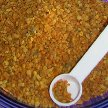BEE POLLEN:
Pure and Natural Bee Pollen from California:
We are getting this ALL natural Bee Pollen from a family who have been
beekeepers in California for over 93 years, devoted exclusively to producing
”Fluffy Fresh” pollen from their own bee hives.
They sell pollen and pollen only!
This family is committed to providing the finest quality bee pollen available.
They understand the importance of being good stewards of their hives and the land where they gather pollen, knowing that this allows their bees to produce large volumes of high quality pollen. Their pollen reflects a wide mix of floral sources, which is gathered frequently and then quickly frozen to maintain the integrity of its nutritional value.
“Since this natural substance contains so many essential nutrients, it has become known as a powerful food supplement, providing super-nutrition when added to a birds daily diet.
Enhance Color and Plumage:
Additional vitamins and minerals have shown to enhance color and plumage in birds. Bee pollen has also proved helpful in some cases of feather picking.
Interesting Bee Pollen Facts:
Pollen is the dust-sized seed found on the stamen of all flower blossoms.
Many people are surprised to learn that there are actually three types of pollen:
1) Entomophilous pollen is distributed by insects, specifically bees. Pollen grains of entomophilous plants are generally larger than the fine pollens of anemophilous plants, and possess higher nutritional value.
2) Anemophilous pollen is spread by wind. Almost all allergen pollens are anemophilous (e.g. ragweed pollen, which causes hay fever). Pollen from anemophilous plants tends to be smaller and lighter in weight than entomophilous pollen, with very low nutritional value.
3) Zoophilous pollen is spread by birds, reptiles, and mammals.
Bee pollen is a source of nutrition for the members of a bee colony:
A full colony of bees can actually pull in as many as 50,000 loads of pollen a day. Each bee makes an average of 10 pollen runs a day, flying up to 2 miles between its hive and surrounding flowers to gather nectar and bee pollen.
The pollen collects on the legs of honeybees as they move from flower to flower in search of nectar. The bees secrete nectar and special enzymes into the flower pollen to create what we know as “bee pollen.” The bees pack the pollen into granules by adding honey or nectar from honey sacs, as well as an enzyme that prevents germination and metabolizes the pollen for food.
Bee Pollen is a wonderful way to get all the nutrition that is needed for life:
It is sometimes called a “whole food/ superfood”, which means that it contains all of the nutrients that are essential for life.
Bee Pollen for Allergies in People:
More and more allergy sufferers are aware of the allergy-fighting effects found in natural bee pollen.
According to WebMD, 20% of Americans suffer from allergies. Approximately 60 million of us experience the effects of allergies – ranging from sniffling noses and scratchy throats, to uncontrolled sneezing and itchy, watery eyes.
An All-Natural alternative to over-the-counter remedies:
In their search for relief, allergy suffers are faced with a confusing array of over-the-counter nasal sprays and pills to alleviate their symptoms. One alternative that many allergy sufferers know about is the allergy-fighting benefits of bee pollen. Specifically, 100% Natural Bee Pollen from California.
Allergy season begins in February:
In some parts of the country, allergy season can start as early as February when trees begin to blossom and pollen is at its heaviest. That’s why it’s important for allergy sufferers to start taking bee pollen as early in the year as possible, in order to begin building immunity to the allergens prior to allergy season.
Immune system-friendly nutrients:
Natural bee pollen, taken as a dietary supplement, is shown to be high in B-complex, C, D, and E vitamins. Bee pollen also contains lecithin, beta-carotene, and selenium – all which contribute to strengthening your immune system.”
Bee pollen varies dramatically in color, depending on the floral source from which it was gathered:
For example, bee pollen from an asparagus is bright orange, while pollen from cucumbers and melons is pale yellow. Pollen from a crab apple tree is light olive, and a horse chestnut tree’s is red. Poppies produce gray bee pollen, and fireweed yields blue pollen.
Fresh bee pollen is fluffy, never hard and when frozen, the bee pollen will stay fresh for 1 year.
Bee Pollen (4 oz).....$5.95 each
Bee Pollen (16 oz)...$19.95 each



